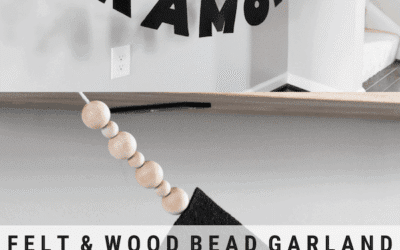Learn how to preserve insects in resin, including how to get rid of bubbles in resin and how to avoid them in the first place by mixing the right way! I’m also sharing how to dry and prep insects for resin using dead Brood X cicadas.
There is a lot of overlap between bug people and plant people. I’m a plant people, but I am not a bug people. I am actually a bit squeamish about bugs, even the ones I know are beneficial. But I’m on the East Coast, which means we just got hit by the Brood X cicadas!
Have you heard of Brood X? Cicadas come in generations, and Brood X, or Brood 10, emerged in 2021 on the east coast. They come roughly every 17 years, so the last time they emerged was 2004.
They have been underground that long and all emerged at once to reproduce. But if you don’t like bugs, you probably don’t love the idea of millions of cicadas crawling out of the ground.
Luckily we didn’t get hit too hard where we’re at on the east coast, but some of the counties around us did! And they are pretty cool. So I decided to commemorate the once-every-17-years occasion by preserving cicadas in resin.

Before everyone loses their minds, don’t worry—I didn’t kill cicadas. A lovely friend of mine went foraging in a nearby forest and collected a bunch of cicada carcasses that were already dead. I was worried that the carcasses would be too fragile, but they worked just fine!
So I did a lot of research about how to prep dead bugs for preserving them in resin. I settled on a few different approaches to test, and all of them worked with varying levels of success. But the prep was the same for each approach.
Before we talk about how to preserve insects in resin, we need to go over how to prep the insects themselves. The bodies. The carcasses. The shells. Whatever.
First collect those carcasses! Obviously try to find the ones that are dead or very near dead. (When my friend collected her cicada bodies, she said a few of them were twitching just slightly, but they had already fulfilled their Earthly task!)

Next you need to freeze them. I just popped mine in a glass jar and kept the lid off. I kept the bodies in the freezer for a little over 24 hours just to make sure everyone was good and dead.

After the big freeze, soak them in alcohol. The alcohol is excellent for cleaning the bugs and helps to preserve them. I used isopropyl alcohol, but pure ethanol (grain or ethyl alcohol) is generally the best (though harder to get).
I got a lot of my information about soaking and preserving insects in alcohol from Oregon State’s detailed article, which you can check out here.


After soaking the bugs in alcohol for a few hours, I laid them out on paper towels to dry overnight. Definitely make sure they dry completely before you put them in resin.

After freezing, soaking, and drying the cicadas, it’s time to get to the good part. The resin! I have worked with resin a decent amount in the past, so I had some of the tools already. Here’s what I recommend using:
- Two-part epoxy resin (I tried two brands, my favorite and a second brand when my favorite was out of stock…more on that in a bit)
- Resin mixing supplies, small silicone molds, a tray, or something else to hold the resin
- My heat gun—if you don’t have a heat gun or don’t want to invest in one, you can use a small torch. I also share a few other methods you can use to avoid a heat gun later in this post.
- Disposable gloves and a mask depending on the type of epoxy resin you use and the level of odor—I didn’t use a mask but was working with a low-odor resin in a well-ventilated area with windows open. Follow the instructions on your resin brand’s container.
I have used a couple different types of resin in my crafts. My favorite is ETI resin, any of their two-part stuff. It is easy to work with and dries SUPER clear.
However, when I went to pick up some more, Joann was out. So I had to get Amazing Clear Cast resin. It worked really well too and had fewer bubbles, but it seemed to be slightly less clear.
I only worked with it on this project, though, so I will reserve judgement on that until I can use it on other crafts. It could have been user error on my part.

Want to learn more about working with resin? Check out my posts on the differences between shiny and matte silicone molds, my DIY resin and wood serving tray, and my paint pour epoxy resin art—great for beginners!
Whatever type of resin you choose to use, read all of the instructions on the brand’s box! Seriously, if you’re new to resin, don’t assume you know what to do.
You have to work quickly, so read everything in advance and get all of your supplies ready. The steps are the same no matter what brand of two-part epoxy resin you use.
Make sure you’re working on a table you don’t mind making a mess on. Or put down a protective plastic bag (resin will soak through kraft paper and cloth). Here’s how to preserve insects in resin.
The first step is to measure out and mix the resin. I recommend mixing only a small amount of two-part resin first. Resin sets up really quickly, so you’ll need to do a few different rounds of mixing.
Use a measuring/mixing cup to pour as close as you can possibly get to a 50/50 ratio. Pour each part slowly and with the cup slightly angled. Then use a stirrer to mix thoroughly but slowly.

Next slowly pour a small amount of resin into a silicone mold. Then wait a few minutes; you’ll notice air bubbles starting to emerge. Use a heat gun or a small torch to pop the bubbles as they emerge.
After about 5 minutes, the resin will already be starting to set up. Use tweezers to set the cicada into the resin. Continue monitoring for bubbles and popping them with air and heat.

To get rid of bubbles in resin you need to use air and heat. I have used a hair dryer before, but the air is a bit powerful, and it can blow resin out of smaller projects.
Therefore, I usually use a heat gun. Typically on medium heat and a low air flow setting. Sometimes I turn it up to the higher fan setting for stubborn bubbles. I don’t turn it above medium heat, though. The resin will start to smell awful.
If you don’t want to get a heat gun, you can get a small torch to use. You can pick these up at any hardware store. A lot of people use a straw and blow out the bubbles individually, but I have never had much luck with that.
Plus, if you use a straw to blow out the bubbles, you risk adding moisture to the mixture from your spit. Or just blowing in other imperfections that will show in the resin.

After about a half hour or so, the first resin pour should be solidified enough that the cicada will stay in place when you pour the rest of the resin. If you don’t let it solidify first, the cicada won’t stay in place and will just float to the top.
Mix enough two-part resin to fill the rest of the mold. For the small-sized mold I used, I only needed about two pours. After a few minutes, monitor for more bubbles. Pop as necessary until you don’t see any more emerging.

Then let the resin cure fully. It will remain tacky to the touch for a few hours, but it will still be slightly pliable. I recommend leaving the resin in the mold to cure fully overnight, 24 hours if it’s really hot and humid where you are!
Then just pop it out of the mold. I didn’t use anything to grease or lubricate the mold before pouring the resin and everything popped out just fine.

Now here’s the frustrating part. Despite using my heat gun, I still dealt with a lot of air bubbles in the resin. Argh. I was really going for a crystal clear look so the bubbles were annoying me. I decided to tweak the approach a bit.
Before I did all of the steps I just outlined, I submerged a single cicada in a small amount of resin to coat it. I did this because I think a lot of the nooks and crannies on the cicada were harboring a lot of air, leading to lots of bubbles that weren’t escaping to the top to pop.
So I put the resin in a cup, put a cicada in, and made sure to cover it inside and out. Then I set it out to dry on two toothpicks over the resin mixing cup. This is so the excess resin can drip off.

After a few minutes, I gave it a quick bit of air with my heat gun to pop air bubbles. My goal here was hopefully to seal off some of the air pocket areas with resin because submerging it into the silicone mold.
This did end up preventing some of the bubbles, but ugh—they were still there! Ultimately I decided to stop trying the square and triangle molds because resin ain’t cheap.
If I had more resin and patience, I think I would have tried to remove the additional bubbles in future attempts by doing several shallow pours instead of just two pours.
Popping bubbles in each layer would be super effective, but I wasn’t keen on taking that route. I wouldn’t call them a failure, though! They are still preserved in resin, and the bubbles are kind of cute. 🙂
I moved on to trying a shallow tray next. Shallow = less resin = easier to pop all of the bubbles!


A tray is a nice option because it is not as deep and requires less resin. That means it’s cheaper and you can get rid of the air bubbles more easily! My first attempt was using a wooden black tray I had painted black for a previous project.
It turned out great, but unfortunately the cicadas really blended in with the black paint. Argh. I wasn’t thinking that one through was I. I didn’t want to use white paint, though. White can yellow in resin.
So I decided to use an unfinished wood tray instead. (I painted one using acrylic paint.) You can pick one up at any craft store. Follow the same steps as you’d follow for a mold. Freeze the cicadas, soak in alcohol, and then let them dry completely.





Pour a thin layer of resin into the tray, pop bubbles, set cicadas, and monitor for bubbles for 10 or so more minutes. After about an hour, you can do your second resin pour to completely encase the cicadas (or other insects) in resin.
If you do the next pour too soon—even if the resin seems to be solidified—the heat from the heat gun or torch can remelt it and cause the cicadas to float to the surface.
Monitor for bubbles and pop. Woo hoo, MUCH more crystal clear than the thicker molds. Here is the final result of my attempt to preserve cicadas in a tray using resin.



While it’s hard to completely get rid of bubbles in resin projects, there are some things you can do to avoid them in the first place. I have used a few different brands and have found that generally bubbles emerge about the same.
Here are a few of the things you can do to avoid bubbles when preserving insects in resin—this isn’t a comprehensive list, but it is based on my experience working with resin:
- Use a high-quality resin; anything from a hardware or craft store is likely fine. ETI is my favorite brand, and any of their resin lines work well.
- Pour each part of the resin into the mixing cup slowly and at an angle; you might be able to prevent some extra air from getting into the mixture.
- Mix thoroughly but slowly; this is a delicate balance because the resin won’t harden properly if it isn’t completely mixed, but you also don’t want to mix too quickly. Mixing slowly can help prevent air bubbles.
- Pour in multiple shallow pours. If you fill the entire mold at once, your bug will not only float right to the top of the mold…but it will also prevent some of the bubbles from escaping. Let the resin solidify and pop bubbles between each pour.

Pin my tips about how to preserve insects in resin!







0 Comments